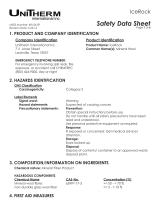Page is loading ...

Shield Fire Protection
ISO 9001-2008 Registered
E-mail: info@shieldprotects.com * Website: www.shieldprotects.com
FIRE EXTINGUISHER RATINGS EXPLAINED
The Underwriters Laboratory fire extinguisher ratings consist of a letter and numerical designations, for
example, 4A or 10B. The letter designation is for the class of fire for which the extinguisher is
acceptable. The following are the letter designations for the different classes of fire;
Class A = Fires that involve ordinary combustibles such as wood, paper, cloth, and rubber.
Class B = Fires that involve flammable liquids such as oil, flammable gases, and alcohols.
Class C = Fires that involve energized electrical equipment. For this classification it is the nonconductivity
of the extinguishing agent that is tested.
Class D = Fires that involve combustible metals.
Class K = Fires that involve cooking oils and fats.
The numerical portion of the rating indicates the extinguishing potential of a fire extinguisher. These
numerical designations are based on comparative fire tests using specific size fires for each numerical
designation. As the numerical designation increases the potential fire-fighting ability of the extinguisher
increases, i.e., an extinguisher that has a 3A rating has the potential to extinguish a larger wood fire than
an extinguisher with a 2A rating. Only the Class A and Class B fires have numerical ratings associated
with them. Class C, Class D, and Class K fires are not tested on comparative size fires. The Class C rating
is based on testing to verify the extinguishing agent does not conduct electricity. The Class D and K
ratings are based on a standard fire test of a fixed size. If an extinguisher passes those tests it gets the C,
D, or K rating.
Most fire codes will specify a minimum rating that is necessary to protect a fire hazard. It is the
customer’s choice if they want to select an extinguisher with a rating that is greater than the minimum
requirement. For example, many fire codes will specify a minimum rating of 2A:20B:C for certain fire
hazards. It is perfectly acceptable to exceed this minimum requirement and install an extinguisher with a
higher rating, such as 3A:40B:C. Many customers feel safer knowing the extinguisher they have selected
has a higher fire-fighting potential than just the minimum.
P.O. Box 428 * 110 Kings Rd * Kings Mountain, N.C. 28086-0428 * 704-739-7415
/


